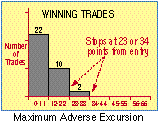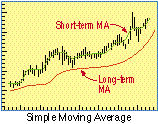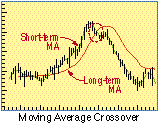|
A partir de 13/02/2025 esta página deixará de ser atualizada.
|
Glossário sobre Análise Gráfica
( A-C )
( D-F )
( G-J )
( K-M )
( N-S )
( T-Z )
- Knowledge Base
- In artificial intelligence, a given inventory of knowledge specific to a set of rules.
- KST
- Indicator developed by Martin Pring. A weighted summed rate of change oscillator. Four
different rates of change are calculated, smoothed, multiplied by weights and then summed
to form one indicator.
- Kurtosis
- Descriptive measure of how flat or pointed a distribution is.
- Lag
- The number of data points that a filter, such as a moving average, follows or trails the
input price data.
- Latest Quarterly Earnings
- (%) The percentage change from the latest earnings earnings reported compared with the
same quarter a year earlier.
- Law of Series
- A succession of random events, such as flipping a coin.
- Lead
- The number of data points that a filter, much as a moving average, precedes the input
price data.
- LEAPS
- Acronym for long-term equity anticipation securities , which are long-term listed
options, with maturities that can be as long as two and a half years.
- Least Squares Method
- A technique of fitting a curve close to some given points that minimizes the sum of the
squares of the deviations of the given points from the curve.
- Leg
- One side of a spread.
- Leg Out
- In rolling forward in futures, a method that would result in liquidating a position.
- Limit Move
- A change in price that exceeds the limits set by the exchange on which the contract is
traded.
- Limit Order
- An order to buy or sell when a price is fixed.
- Limit Up, Limit Down
- Commodity exchange restrictions on the maximum upward or downward movements permit ted
in the price for a commodity during any trading session day.
- LISP
- A programming language based on predicate logic and is the one most commonly used in
artificial intelligence applications.
- Ljung-Box statistic
- A chi-square test of significance of higher order correlation existence. The marginal
significance level is the probability that a no more higher order correlation exists.
- Load
- Commission and fees taken out of investment capital; that is, the situation in which a
front-loaded mutual fund takes commission and fees out of investment capital before the
money is put to work.
- Local
- The trader in a pit of a commodity exchange who buys and sells for his or her account.
- Locked Limit
- A market that, if not restricted, would seek price equilibrium outside the limit but,
instead, moves to the limit and ceases to trade.
- Long
- Establishing ownership of the responsibilities of a buyer of a tradable; holding
securities in anticipation of a price increase in that security.
- Lookback Interval
- The number of periods of historical data used for observation and calculation.
- Low Pass Frequency Filter
- A data smoother or filter that lets pass low frequency trend sinusoids and rejects high
frequency noise (see SMA).
- Low-Ticking
- To sell at the bid price.
- MACD
- See Moving Average Convergence/Divergence.
- Macro
- A computer method commonly used in spreadsheets to automate repetitive steps by
recording the necessary keystrokes. The macro can then be run and the keystrokes
implemented.
- Major Auction
- The overall trend of the market such as might be observed on a bar chart.
- Mandelbrot Set
- Complex but structured pattern produced by an equation in which the result is fed back
into the equation repeatedly; self-similarity.
- Mapping
- A function, or relation between values.
- Margin
- In stock trading, an account in which purchase of stock may be financed with borrowed
money; in futures trading, the deposit placed with the clearinghouse to assure fulfillment
of the contract. This amount varies daily and is settled in cash.
- Marginal Significance Level of Test-Statistics
- The probability distribution used to test the hypothesis that the beta coefficient does
not equal zero. A T-statistic of approximately 1.65 reflects a 0.90 or 90% confidence and
the mar ginal significance is 1-0.90 = 0.1 or 10%.
- Marked to Market
- At the end of each business day the open positions carried in an account held at a
brokerage firm are credited or debited funds based on the settlement price of the open
positions that day.
- Market If Touched
- Resting order with the floor broker that becomes a market order to be executed if the
trigger price is traded.
- Market Maker
- A broker or bank continually prepared to make a two-way price to purchase or sell for a
security or currency.
- Market on Close
- An order specification that requires the broker to get the best price available on the
close of trading, usually during the last five minutes of trading.
- Market Order
- Instructions to the broker to immediately sell to the best available bid or to buy from
the best available offer.
- Market Risk
- The uncertainty of returns attributable to fluctuation of the entire market.
- Market Sentiment
- Crowd psychology, typically a measurement of bullish or bearish attitudes among
investors and traders.
- Market Timing
- Using analytical tools to devise entry and exit methods.
- Market Value
- Company value determined by investors, obtained by multiplying the current price of
company stock by the common shares outstanding.
- Markov Chain
- A set of processes where the probabilities for the next state are dependent on the
present state.
- Martingale
- From roulette; a tactical system that requires doubling your bet after each loss, so
that winning once you recoup the amount originally bet.
- Matif
- The Marche A Terme Des Instruments Financiers exchange in Paris.
- Maxima
- The highest or maximum value.
- Maximax
- Optimistic decision-making that identifies the decision alternative with the best
possible outcomes.
- Maximin
- Pessimistic decision-making that identifies the decision alternative with the worst
possible outcomes.
- Maximum Adverse Excursion

- A historical measurement of the closed losing trades versus the closed profitable trades
of a trading system. Used to determine the stop-loss level that can be used that will
allow winning trades to remain; the extreme unfavorable price level reached for both
profitable and unprofitable trades.
- Maximum Entropy Method
- More flexible than Fourier analysis, the maximum entropy method is both a tool for
spectrum analysis and a method of adaptive filtering and trend forecasting. As a tool for
spectrum analysis, the MEM system can provide high resolution spectra for identifying the
dominant data cycles within relatively short time series, such as open, high, low, close,
volume and open interest, or study results, such as RSI, TRIX, and so on. (Fourier
analysis, in contrast, gives best results when applied to time series of six months or
longer.) As a forecasting tool, MEM is used in conjunction with moving averages to
forecast lower and upper trend channels in the data.
- Maximum Entropy Spectrum Analysis
- See Maximum Entropy Method.
- Mean
- When the sum of the values is divided by the number of observation.
- Mean Deviation
- The average absolute value of the difference between the population of numbers and the
mean.
- Mean Return
- The average monthly total return of a stock. The total return is price change added to
dividends.
- Mean Reverting
- The term adopted in academic literature for one possible state of a price series: that
state when price is oscillating randomly about some (unknown) mean value. That is, it is
not trending.
- Median Line
- The line that is drawn from an extreme that bisects a line drawn through the next
corrective phase after the pivot point. See Andrews Method.
- MEM
- See Maximum Entropy Method.
- MESA
- See Maximum Entropy Spectrum Analysis.
- Minima
- The lowest or minimum value.
- Minor Auction
- The latest trend of the market, i.e., what it is doing now.
- Mode
- The most frequently occurring value.
- Model
- Equation.
- Momentum
- A time series representing change of today's price from some fixed number of days back
in history.
- Momentum Filter
- A measure of change, derivative or slope of the underlying trend in a time series.
Implemented by first applying a low pass filter to the data and then applying a
differencing operation to the results.
- Momentum Indicator
- A market indicator utilizing price and volume statistics for predicting the strength or
weakness of a current market and any overbought or oversold conditions, and to note
turning points within the market.
- Monowave
- In Elliott wave theory, a single wave within a range of waves.
- Moving Average

- A mathematical procedure to smooth or eliminate the fluctuations in data and to assist
in determin ing when to buy and sell. Moving averages emphasize the direction of a trend,
confirm trend reversals and smooth out price and volume fluctuations or "noise"
that can confuse interpretation of the market; the sum of a value plus a selected number
of previous values divided by the total number of values.
- Moving Average Crossovers

- The point where the various moving average lines intersect each other or the price line
on a moving average price bar chart. Technicians use crossovers to signal price-based buy
and sell opportunities.
- Moving Average Model
- A time series equation representing an observed value at time t as a linear combination
of present and past random shocks et (forecast errors). A moving-average process of order
Q, MA(q), may be written

- Moving Average Convergence/ Divergence (MACD)
- The crossing of two exponentially smoothed moving averages that are plotted above and
below a zero line. The crossover, movement through the zero line, and divergences generate
buy and sell signals.
- Moving Window
- Snapshot of a portion of a time series at an instant in time. The window is moved along
the time series at a constant rate.
- Multicolinearity
- Two variables that have a correlation of greater than 0.70 or less than -0.70 in a
regression model. The final result is the two variables explaining the same portion of
variation where either variable would be suffi cient.
- Multiple Linear Regression
- More than one independent variable is used to account for the variability in one depen
dent variable.
( A-C )
( D-F )
( G-J )
( K-M )
( N-S )
( T-Z )
|